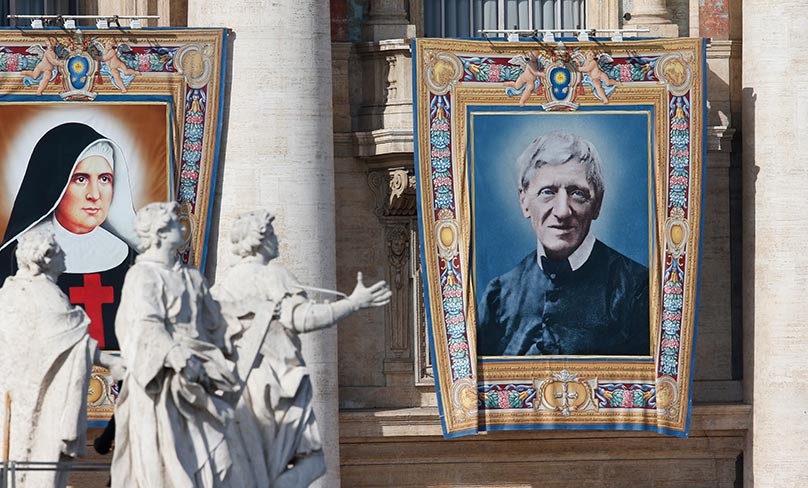
On Saturday, October 12, the Thomistic Institute at the Pontifical University of St. Thomas Aquinas (familiarly known the Angelicum) hosted a conference in anticipation of the canonization of John Henry Newman the following day.
Speakers at “Newman the Prophet: A Saint for Our Time,s” which was held in the John Paul II Aula Magna of the Angelicum, included Archbishop Bernard Longley of Birmingham; Sister Catherine Joseph Droste, OP, dean of the theology faculty at the Angelicum; Dr. Tracey Rowland of Australia’s University of Notre Dame; Fr. Guy Nicholls, CO, of the Birmingham Oratory and Oscott College; Archbishop Anthony Fisher, OP, of Sydney, and Dr. Thomas Farr of the Religious Freedom Institute. The conference host was Father Thomas Joseph White, OP, who leads the Angelicum’s Thomistic Institute,
The opening address to the conference, “Lead, Kindly Light – The Story of a Saint,“ was delivered by George Weigel, who suggested some connections among Newman’s life and work, the contemporary Catholic situation, and Synod-2019 . [XR II]
Lead, Kindly Light – The Story of a Saint
George Weigel
Good afternoon, everyone. Let me begin by thanking Father Thomas Joseph White and the Thomistic Institute for the invitation to open this conference with some personal reflections on John Henry Newman and his meaning for today. It’s a great pleasure to share this great occasion – especially for the Church in the Anglosphere, as one of its noblest sons is raised to the glory of the altars – with so many old friends.
In February 2003, the fathers of the Birmingham Oratory honored me with an invitation to deliver the laudatio at the “Musical Oratory” marking John Henry Newman’s 202nd birthday. It was a marvelous evening of music and intellectual reflection, wine and fellowship. But what remains most firmly in my memory was the half-hour I had spent earlier that day in Cardinal Newman’s rooms, which had been left the way they were at his death.
I sat in his chair before the fireplace, fingered the small brandy glasses from which he warmed himself of a chill evening, and held the Latin breviaries with which he had prayed even before entering into full communion with the Church of Rome.
On one wall, there was a yellowed but still readable map from the Times of London, on which Newman had followed the path down the Nile of General Kitchener’s expedition to relieve the siege of Khartoum and rescue General Charles Gordon; and I remembered that Gordon, who was of course murdered by the forces of the Mahdi before Kitchener’s troops arrived, had prepared for death by reading Newman’s poem, “The Dream of Gerontius.”
Inside the old upright wardrobe was the galero, the ceremonial red hat bestowed on Newman by Pope Leo XIII in 1879.
And pinned around the altar were brief notes in Newman’s own hand, or sent to him by others, reminding him of those for whom he had promised to pray.
The next day, I was given leave to ramble through Newman’s horseshoe-shaped, two-tiered library; and it’s not easy to convey the emotion I felt when I lifted off the shelf a large folio volume of the Opera Omnia of Pope St. Gregory the Great and read on the flyleaf the inscription, “To my dear friend J.H. Newman, E. Pusey.”
But it was while sitting in Newman’s room in his chair that the thought occurred, was his a life of change or continuity?
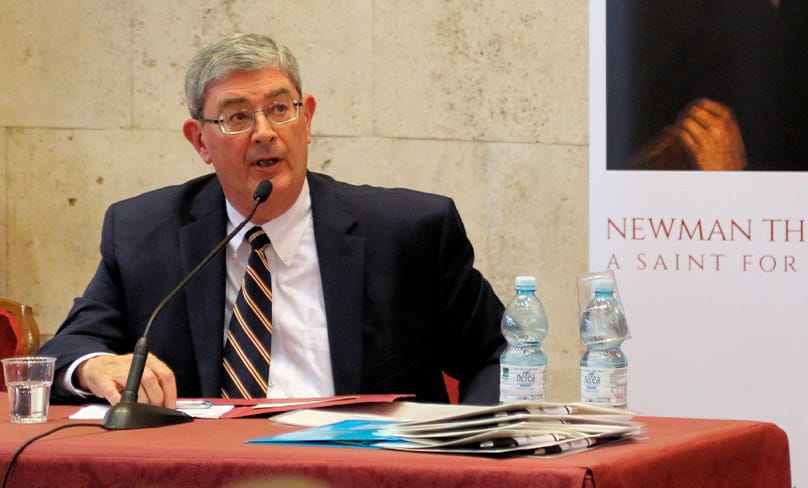
Continuity and Change. When Cardinal Newman died in 1890, Lord Rosebery, who would become prime minister of Great Britain four years later, came to the Birmingham Oratory church to pay his respects; Rosebery was the last of the Liberal grandees, a man of whom Churchill’s secretary, John Colville, once wrote, “He was likely to have had a copy of Das Kapital in his library, but in a special edition with a calfskin binding.” In any event, after contemplating Newman laid out before the altar of the Oratory Church, Rosebery wrote in his diary: “This was the end of the young Calvinist, the Oxford don, the austere vicar of St. Mary’s. It seemed as if a whole cycle of human thought and life was concentrated in that august repose. That was my overwhelming thought. Kindly light had led and guided Newman to this strange, brilliant end.”
Was there something really “strange” about Newman’s destiny, and the life in which he fulfilled it? However dramatic the changes in his life seemed on the surface of history, was there not far more continuity than change, when Newman’s life was read in its true, spiritual depth?
It was, after all, Newman who, in the “Meditations on Christian Doctrine,” insisted of God, that “He knows what He is about.”
It was, after all, Newman who demanded of himself, and held himself to this challenging commitment: “I shall be a preacher of truth.”
So while there was certainly change over the long course of Newman’s eventful and contentious life, there was also a genuine, deep-running continuity. That was the continuity of the radically converted Christian, who, having passed through adolescent skepticism, committed himself wholly and entirely to Jesus Christ, the answer to the question that is every human life – and to the Church that is Christ’s mystical body in the world.
And amidst that continuity of faith, there was a continuity of conviction: that the faith, in modernity, was under assault from a particularly dangerous enemy, dangerous because it appealed to modern humanity’s fascination with itself and modern humanity’s constant temptation to confuse tolerance with indifference to the truth of things
That conviction was most memorably expressed in the famous “Biglietto Speech,” which Newman delivered on May 12, 1879, on receipt of the official notification of his enrollment in the College of Cardinals. There, after some preliminary words of thanks to Leo XIII, Newman had this to say about himself:
“In a long course of years I have made many mistakes….but what I trust that I may claim all through what I have written is this – an honest intention, an absence of private ends, a temper of obedience, a willingness to be corrected, a dread of error, a desire to serve Holy Church, and, through divine mercy, a fair measure of success. And, I rejoice to say, to one great mischief I have from the first opposed myself. For thirty, forty, fifty years I have resisted to the best of my powers the spirit of liberalism in religion. Never did Holy Church need champions against it more than now….
“Liberalism in religion is the doctrine that there is no positive truth in religion, but that one creed is as good as another…It is inconsistent with any recognition of any religion, as true. It teaches that all are to be tolerated for all are matters of opinion. Revealed religion is not a truth, but a sentiment and a taste; not an objective fact, not miraculous; and it is the right of each individual to make it say just what strikes his fancy.”
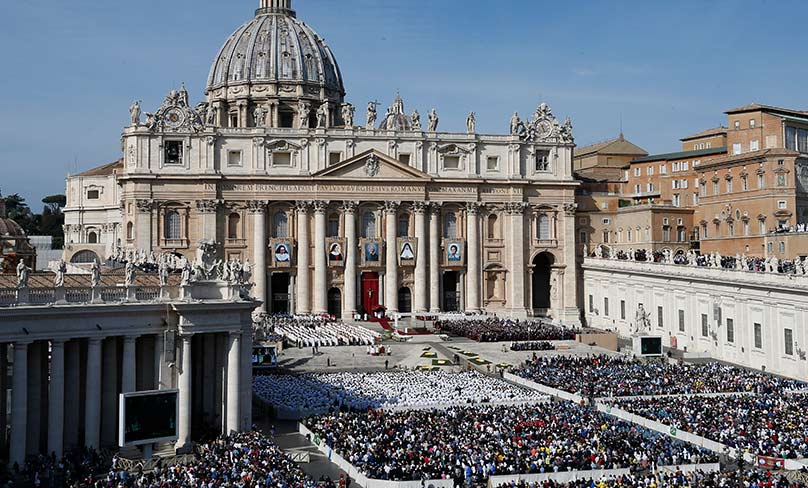
Conscience. Throughout his life, Newman, the man of change and development amidst continuity, was guided by the promptings of his conscience, which he took to be the voice of God speaking to us through what he termed “the aboriginal Vicar of Christ.”
Many of you will be aware of the impact that Newman’s writings on conscience had on the young Joseph Ratzinger in the aftermath of the Second World War. Perhaps not so well known, however, is the impact that Newman’s sermons on conscience had on the young Germans of the anti-Nazi White Rose movement, including the most famous member of that resistance organization, Sophie Scholl, who was beheaded for treason in 1943.
When Sophie Scholl’s boyfriend, Fritz Hartnagel, was sent by the Wehrmacht to the Russian front in 1942, Sophie gave him two volumes of Newman’s sermons. Fritz later wrote Sophie that “we know by whom we are created, and that we stand in a relationship of moral obligation to our creator. Conscience gives us the capacity to distinguish between good and evil”—words, British author Paul Shrimpton observed, that “were taken almost verbatim from a famous sermon of Newman’s called ‘The Testimony of Conscience.’” On the witness stand before the odious Judge Roland Freisler in the notorious Nazi “People’s Court” in Munich, twenty-one-year old Sophie Scholl testified that it was her conscience, and her Christian conviction, that had led her to nonviolent resistance against Hitler and his gangsters. That Christian conscience was formed in part by a serious intellectual and spiritual encounter with the man we shall know, from tomorrow, as Saint John Henry Newman.
There is a lot of talk in the 21st-century Church about “conscience,” and Newman is invoked by many prominent personalities in those debates. So it might be useful for all concerned to ponder Newman’s influence on these contemporary martyrs.
What did the members of the White Rose learn from Newman about conscience?
They learned that conscience could not be ignored or manipulated.
They learned that the voice of God speaking through our consciences sets before us what is life-giving and what is death-dealing.
They learned that conscience can be stern, but that in submitting to the truths it conveys, we are liberated in the deepest meaning of human freedom.
They learned that obedience to conscience can make us courageous, and that to strive to live an ideal with the help of grace is to live a truly noble life with an undivided heart.
These themes are of obvious significance for the Church today.
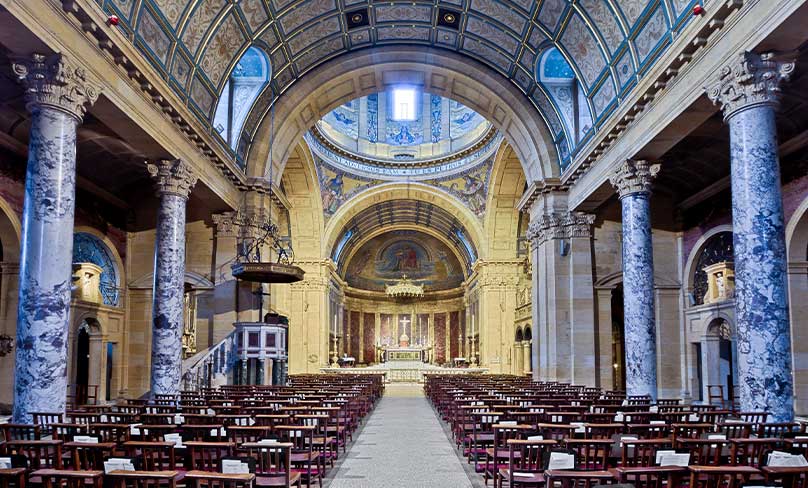
Doctrinal Development. The continuity of the radically converted Christian disciple was also evident in Newman’s work on the development of doctrine.
The marks of a true development of doctrine that Newman identified were, I suggest, themselves a development of the work of St. Vincent of Lerins, which many of us read in the Divine Office yesterday. As you will remember, Vincent, anticipating Newman’s Essay on the Development of Christian Doctrine by 1,400 years (and Gaudet Mater Ecclesia, John XXIII’s opening address to the Second Vatican Council by 1,500) insisted that the “development of religion in the Church of Christ…must truly be a development of the faith, not [an] alteration of the faith. Development means that each thing expands to be itself, while alteration means that a thing is changed from one thing to another. The understanding, knowledge, and wisdom….of the whole Church ought, then, to make great and vigorous progress with the passing of the ages and the centuries, but only along its own line of development, that is, with the same doctrine, the same meaning, and the same import.”
Development, not “paradigm shifts,” was what characterized Newman’s path in following the kindly light – as it was what characterized Newman’s theological concept of how the Church’s self-understanding deepens and expands over time. We see that theology vindicated in the Second Vatican Council’s teaching on the nature of the Church, on divine revelation, on the office of bishop, and on religious freedom and the modern state.
Churchmanship. The great continuity of Newman’s life, as I have suggested several times here, was his radical discipleship. That discipleship, that deep conversion to Christ, informed a brilliant and subtle mind; it was a conversion so profound that Newman could say, and mean, that “one thousand questions do not amount to a doubt;” and that discipleship was also at the core of Newman as a churchman.
“Churchmanship” is not a term in common use today. That is a shame, for the word suggests qualities of character that are always needed in the Mystical Body of Christ, but especially in times of cultural turmoil and consequent ecclesiastical turbulence. Newman’s churchmanship was never better displayed than in his work before, during, and after the First Vatican Council.
As everyone here surely knows, Newman believed in the infallibility of the Bishop of Rome under certain well-defined circumstances. He also believed that a dogmatic definition of that infallibility at the end of the seventh decade of the nineteenth century was imprudent or, as the language of the day had it, inopportune. And he resisted, with his usual literary vigor, the attempts by some to give papal infallibility so broad a definition as to turn the pope into a kind of oracle on virtually every imaginable question of ecclesiastical and public life.
Yet, when Vatican I adopted a carefully-crafted definition of the nature and range of papal infallibility, Newman not only accepted it in his own mind but defended it in public against the deprecations of the former prime minister, William Ewart Gladstone, in his famous Letter to the Duke of Norfolk. It was a defense of the integrity of Catholic faith that, in the England of his time, only Newman could have successfully made.
This was churchmanship of the highest caliber, and it is a quality of character from which every Catholic today can learn today.
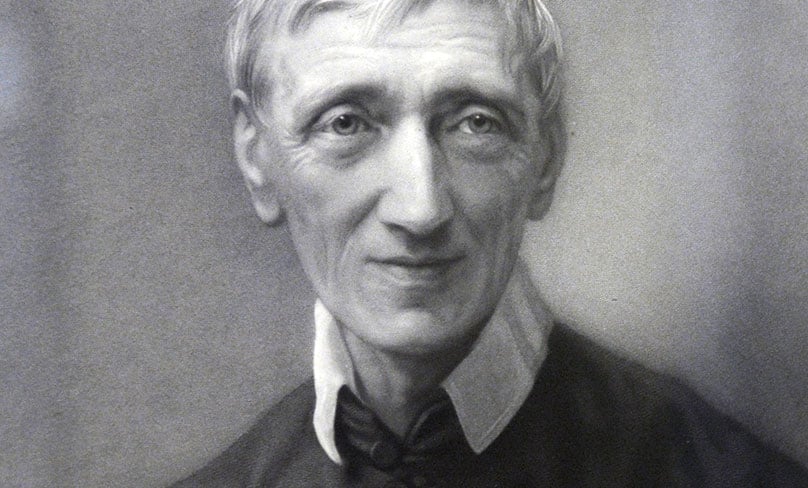
Courage. Finally, there is a deep continuity to be found in Newman’s life in his courage: another quality of mind, heart, and soul – another virtue – that is much needed in Catholicism today.
I will of course defer to great Newman biographers like Father Ian Ker on this point, but it does seem to me that Newman’s displays of courage throughout his life – in his transition from youthful skepticism to evangelical belief, his transition from evangelicalism to the Newman of the Tracts for the Times and the Oxford Movement, his reception into full communion with the Catholic Church, his acceptance of the presidency of a nascent Catholic University in Ireland, his debate with Charles Kingsley, and his aforementioned work during and after Vatican I – did not come so easily. His was a more gentle spirit than the polemicists of his time, and one can easily imagine that he would have much preferred to be left to his scholarship and his life of prayer, rather than being constantly called into the lists of controversy.
But when those calls came, this consummate churchman answered them, spoke the truth (even when that meant speaking truth to power), and in doing so inspired others to do the same.
Newman’s courage was another manifestation of his profound Christian faith. And in his courage, he lived out what he had espoused to others in that “Meditation on Christian Doctrine,” when he wrote, and speaking of God, “Therefore, I shall trust Him….if I am in perplexity, my perplexity may serve Him….My…perplexity…may be [a] necessary [cause] of some great end, which is quite beyond us. He does nothing in vain…He may make me feel desolate, make my spirits sink, hide the future from me – still, He knows what He is about.” We honor the memory of John Henry Newman, this newest of God’s saints, by imitating that courage, and the conviction that underwrote it.
Thank you. Sia lodato Gesu Cristo!
